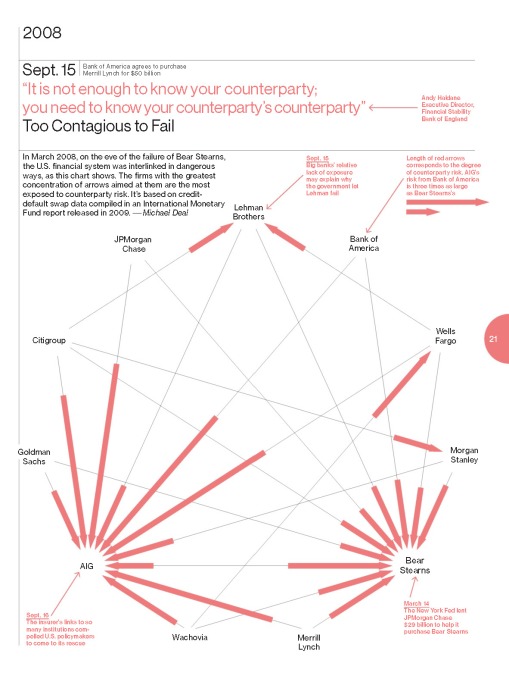Graphic design and typography
Posts Tagged ‘ Bloomberg Business Week ’
Who’s at risk?
This graphic, designed for Bloomberg Businessweek, sets out to demonstrate the connectedness and the risk of the major financial institutions who were at the heart of the stock market collapse in September 2008.
The preponderance of arrows pointing to insurance giant AIG, show that all the banks were at risk if AIG failed. The longer the line, the greater the risk.
Bank of America: the graphics tell the story
This, bold contrasty design sets the tone of the article, that Bank of America, with $2.3 trillion in assets is big: in the eyes of the government, too big to fail.
Warren Buffet’s recent purchase of $5 billion in preferred stock immediately helped the Bank’s share price that has dropped from $13.34 a share in January to $7.48 in early September.


However the sharp upturn in the share price following Buffet’s investment took an equally sharp downturn the next day—graphically illustrated on the right side of the chart on the second spread.
The article in Bloomberg Business Week concludes:
Barnes ticks off the latest statistics from Lender Processing Services, a major home loan servicer: 4.1 million loans nationwide are 90 days or more days delinquent or in foreclosure; delinquency rates are twice their historical average; more than 40 percent of 90-days-plus delinquent loans have not made a payment in more than a year.
BofA is more exposed to those scary figures than any other bank. Moynihan “has got to know there are more losses ahead, enough to kill a bank,” says Barnes. “No model exists for what happens next.”
The Nixon Shock
This spread from Bloomberg Business Week opens an article about the U.S. economy in 1971. Richard Nixon was president and in 1969 the United States balance of payments deficit had reached $7 billion, peanuts by today's numbers but significant 40 years ago.
By the time Nixon resigned in August 1974, inflation was 11 percent and would go even higher.
According to the article, The Nixon Shock was a monetary strategy that involved three points.
First, America would stop converting dollars to gold.
Second, to combat the potential inflationary effects, wages and prices would be frozen for 90 days. This was a bold move given that unions representing, copper, steel and telephone workers were in the midst of negotiating 30 percent wage increases over three years.
And third, the U.S. would impose an import surcharge of 10 percent as a way to pressure other countries to renegotiate their exchange rates.
This is all heady stuff and a bit beyond me, but once again Business Week’s magazine designer has created a striking piece of typography that intrigued me enough to read the article.
Financial article takes a typographic approach
This opening page and spreads from Bloomberg Business Week demonstrate how type, and type alone can draw the eye and reinforce message.
It’s playful, eye catching and informative. The playfulness comes with the tease of the first page, as you have to work a little harder than usual to unravel the title of the article.
On this third spread I really enjoy how the word “Foreclosure” in the upper left becomes progressively negatively letterspaced until the last word is completely closed. A very subtle typographic pun

Bloomberg Businessweek: Some fun with type
I enjoyed this clever typographic cover where the word is created from grain tractors ploughing a wheat field.
It’s credited to Justin Metz/Gallery Stock and so I presume this photograph was not commissioned specifically for this magazine.
The second image, a page from the same issue, is illustrated by Topos Graphics. It’s a serious subject given some wit.
[ Bloomberg Businessweek February 2011 ]
| M | T | W | T | F | S | S |
|---|---|---|---|---|---|---|
| 1 | 2 | 3 | 4 | 5 | ||
| 6 | 7 | 8 | 9 | 10 | 11 | 12 |
| 13 | 14 | 15 | 16 | 17 | 18 | 19 |
| 20 | 21 | 22 | 23 | 24 | 25 | 26 |
| 27 | 28 | 29 | 30 | 31 | ||









